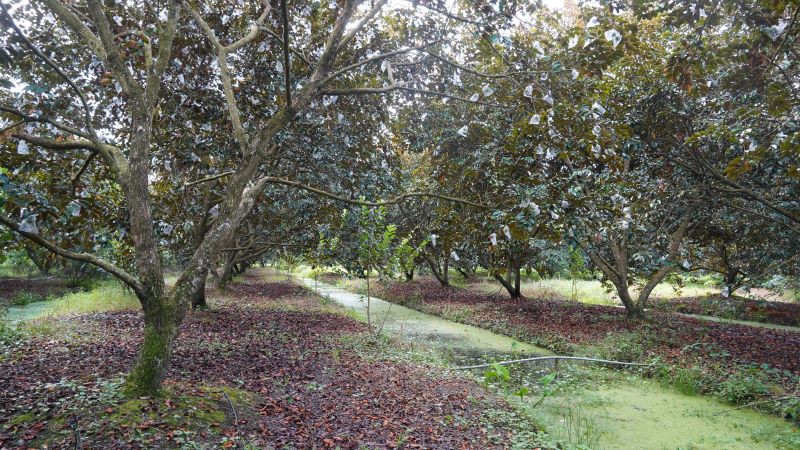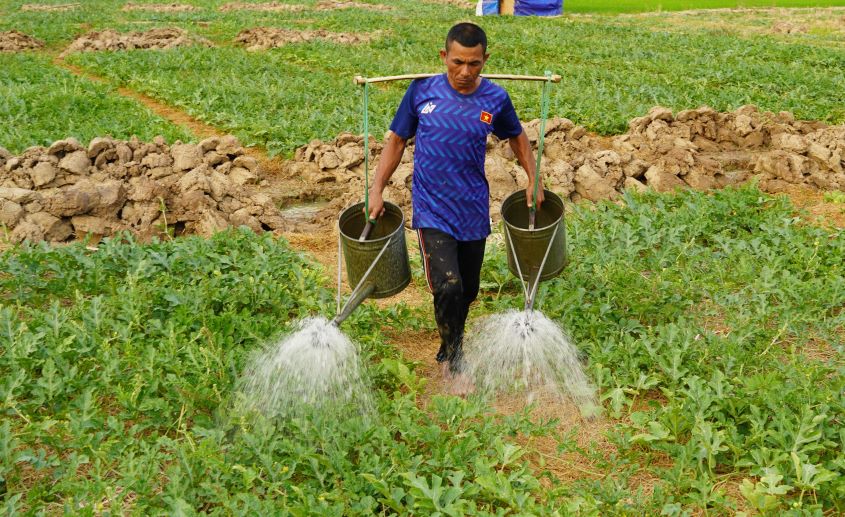Keeping fresh water for the garden
Recognizing the risk of saline intrusion, many gardeners in the fruit growing area of Ke Sach district (Soc Trang province) have invested in a freshwater storage system before the dry season begins.
Mr. Doan Van Ut Xuan - a farmer in Xuan Hoa commune (Ke Sach district, Soc Trang province) - shared: "Although it is quite far from the sea, in recent years, salinity has penetrated deep into the fields. To protect 4 hectares of durian, the family has proactively dredged ponds and ditches to store fresh water. Thanks to that, from 2020 to now, despite the severe salinity, the garden has been watered enough and developed well".

Not only Mr. Xuan, many gardeners in Ke Sach district (Soc Trang province) also apply similar measures. Mr. Nguyen Hoang Anh (in Ba Trinh commune) said that his family regularly monitors salinity information, checks dykes, culverts and stores fresh water in the garden ditches.
"When the salinity rises, I close the culverts to keep fresh water and prevent salinity from entering. When the salinity decreases, I remove the water to water the plants," Mr. Hoang Anh shared.
In Ke Sach town, Mr. Nguyen Huu Cam has also invested in a pond system, a water storage ditch and installed an automatic irrigation system for his family's lemon garden. "The dry season is hot and dry for a long time, but thanks to enough water storage and spraying, the lemon garden always has enough water to water, even during the severe and prolonged drought and salinity," said Mr. Cam.
Flexible adaptation in the field
In addition to storing fresh water, Soc Trang farmers have also proactively converted crops to adapt to the drought and salinity. In Long Phu, Tran De, My Xuyen districts and Soc Trang city, many farmers have switched from growing late winter-spring rice to growing vegetables after harvesting winter-spring rice.
Mr. Lam Tal (in Long Phu commune, Long Phu district, Soc Trang) said that on an area of 3,500 m2, 3 crops are produced each year, then the land is improved and converted to growing Summer-Autumn rice. This method helps save on fertilizer costs, creates fat color for the soil and increases income.
"Thanks to rice rotation - an annual crop that brings in a profit of nearly 200 million VND, I have the conditions to build a spacious house worth more than 300 million VND," said Mr. Tal.

Similarly, Mr. Danh Kim Phat (residing in Ward 7, Soc Trang City) shared that every dry season, his family chooses a few hectares of land to grow watermelon. Last year, thanks to the good harvest and good prices of watermelon, his family earned over 70 million VND in profit after only 2 months of planting and caring.
"Previously, growing 3 rice crops encountered many difficulties due to poor soil color, reduced productivity, unstable prices and high risk of saline intrusion. rotating two rice - one color, especially watermelon, has brought high economic efficiency and improved the soil's fertility," said Mr. Phat.
Mr. Phat added that growing melons in the fields in the dry season does not require much water like rice, helps save water and is suitable for the current drought and salinity intrusion.
According to the Department of Agriculture of Soc Trang province, every year during the dry season, hundreds of hectares of rice fields in the province are converted to grow vegetables. This is considered a good way to create jobs, increase income and help farmers " live well" through the drought and salinity season.
According to the Southern Institute of Water Resources Research, the 2024 - 2025 dry season in the coastal areas of the Mekong Delta will have unusual salinity intrusion, which can affect water resources and production in coastal irrigation systems such as Go Cong, Bac Ben Tre, Tra Vinh coastal areas and the Long Phu - Tiep Nhat system. Therefore, it is necessary to prepare response plans and store and use water appropriately, especially water to ensure fruit-growing areas in Chau Thanh, Cho Lach, and Mo Cay Bac - Nam districts of Ben Tre province; Ke Sach district - Soc Trang province.
It is forecasted that salinity intrusion may reach its largest peak from the beginning of the dry season from February 28 to March 4, 2025, with the largest salinity level of 4g/l on the Mekong River mouths from 45-60km.











